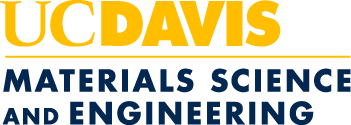
Ph.D. Student Margaret Duncan Receives NSF Graduate Research Fellowship
Second-year materials science and engineering Ph.D. student Margaret Duncan, part of Associate Professor Marina Leite’s lab, received a National Science Foundation (NSF) Graduate Research Fellowship. The fellowship is the oldest and one of the most prestigious of its kind and it recognizes and supports outstanding STEM graduate students who have the potential to become knowledgeable experts and significantly contribute to research, teaching, and innovation.
As part of a collaborative project funded by DARPA, Duncan researches thermo-photovoltaics—materials systems that convert heat into light, and then into usable energy. Thermo-photovoltaics are often used in energy generation systems like nuclear power plants to capture the heat energy by-products and make the entire system more efficient.
“Think about how hot nuclear power plants get during normal operation,” she said. “All that thermal energy is just being wasted. Adding thermo-photovoltaics to anything that has high temperatures involved can give us even more energy out of the process.”
Thermo-photovoltaic systems have two components: an emitter that converts heat into light, and an absorber—a solar cell-like device that turns light into energy. Duncan’s research focuses on designing a better emitter.
“We’re trying to design a better thermo-photovoltaic emitter that is really good at emitting light in the wavelength range that the solar cell would then be really good at absorbing,” she said.

To do this, she is working to identify materials that are highly-efficient, thermodynamically stable at high temperatures and capable of being scaled up for industrial production. An important part of this is making sure they are easy to fabricate. Though efficient emitters are already on the market, they’re often made using nanofabrication, which is an expensive process. Duncan and the team are working on a simpler thin film and substrate design.
“It’s two layers, all flat, very easy to fabricate,” she said. “That’s something you can do in minutes or hours, depending on the material.”
Between Physics and Engineering
Duncan got into photonics through her interest in physics.
“I’m really interested in that boundary of materials science and physics, which photonics is a really huge part of,” she said.
As she looked for graduate programs, she spoke with Leite about the group’s work in photovoltaics and got excited when she learned about the new DARPA project, which is a collaboration between the Leite Lab, Assistant Professor Scott McCormack, Electrical and Computer Engineering Professor Jeremy Munday and the University of Richmond Assistant Professor Mariama Dias. She joined the lab to work on it in 2021.
With the fellowship, Duncan is excited by the freedom to pursue her research and work toward her goal of an industry career in green energy and photonics. She also feels grateful the people who have helped her along the way, especially Leite and the staff scientists and engineers at CNM2 and AMCaT.
“I could not have done this without all the other people in this collaboration,” she said. “They have helped so much with this project and I’m incredibly grateful to have been able to work with them over the past two years. Dr. Leite in particular has really believed in me this entire time, which has meant a lot.”
